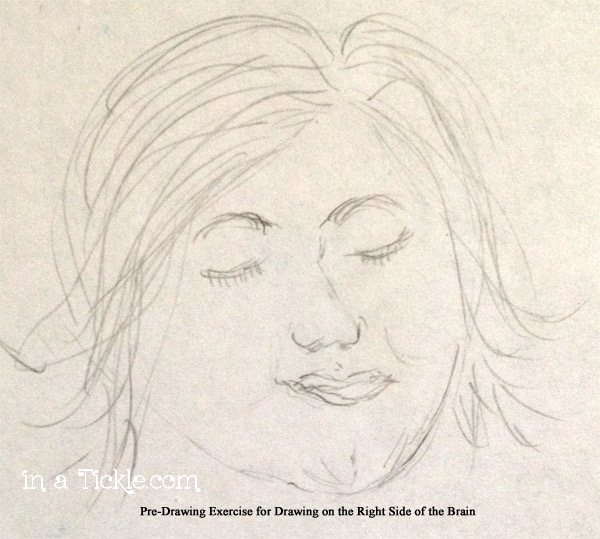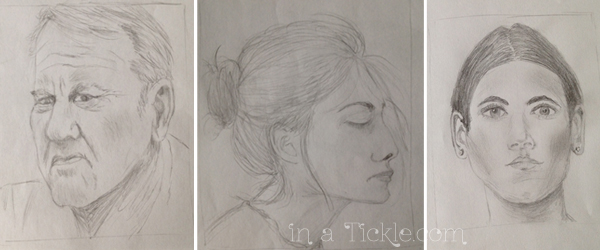I like to draw and want to increase my drawing skills. Like anything else, getting better at something means you have to practice. So lately I have been trying to do more sketching of things– objects, landscapes, plants, etc. But I don’t do faces or any other human body parts. They are too hard, and I just wasn’t gifted in that area. Anyway, that’s what I told myself. At the beginning of this year I decided my word for the year was “stretch”. I wanted to stretch my creative self to try new things, learn new skills, and increase the skills I already had (as well as helping other people to stretch themselves creatively).
I recently borrowed a book from the library that has been on my future “someday I might want to buy this book” list for a long time. I think I even looked at it one time in a bookstore and noticed that a big section of it was devoted to drawing faces and hands and that is probably why it got put on the “someday” list. I have seen the book recommended from time to time in articles I’ve read, so I figured it would be a good thing to read…someday.
The book is Drawing on the Right Side of the Brain by Betty Edwards. The edition I read is the 1989 edition. I understand there are more current revisions of the book. Her basic premise is that anyone can learn to draw once they’ve learned the five basic component skills, just like you can learn the basic skills of riding a bike or skiing. She considers them skills of “seeing” rather than skills of “drawing.” They are:
1. The perception of edges.
2. The perception of spaces.
3. The perception of relationships.
4. The perception of lights and shadows.
5. The perception of the whole.
She also explains the process of training your visual, perceptual right brain to take dominance over the verbal, analytic left brain in order to draw what you see rather then what you think something should be. “Drawing is not really very difficult. Seeing is the problem, or, to be more specific, shifting to a particular way of seeing.”
Her techniques have helped creative people in many fields besides art to “get their working skills under better control and learn to overcome blocks to creativity.”
So why does she include drawing faces in a book geared to beginners? Here is her answer:
Let me explain why I think portrait drawing is useful as a subject for beginners in art. Broadly speaking, all drawing is the same. One drawing task is no harder than any other. The same skills and ways of seeing are involved in drawing still-life setups, landscapes, the figure, random objects, even imaginary subjects, and portrait drawing. It’s all the same thing: you see what’s out there…and you draw what you see.
Why, then, have I selected portrait drawing for some of the exercises? For three reasons. First, beginning students of drawing often think that drawing human faces is the hardest of all kinds of drawing. Thus when students see that they can draw portraits, they feel confident and their confidence enhances progress. A second, more important, reason is that the right hemisphere of the human brain is specialized for recognition of faces. Since the right brain is the one we will be trying to gain access to, it makes sense to choose a subject that the right brain is used to working with. And third, faces are fascinating!
The first pre-instruction exercise is to do some drawings of specific things, one of which was to look at someone and draw their head. I was watching my granddaughter and drew her head. The results were no surprise to me because I can’t draw faces! It did not look like her. I proceeded through the book enjoying doing most of the exercises and then came the chapter on faces. After reading through the lessons and doing the exercises, I am no longer saying, “I can’t do faces.” I actually enjoyed it and want to continue practicing and stretching myself.
I proceeded through the book enjoying doing most of the exercises and then came the chapter on faces. After reading through the lessons and doing the exercises, I am no longer saying, “I can’t do faces.” I actually enjoyed it and want to continue practicing and stretching myself.
The following images are my first three faces. I was looking at a couple of magazine pictures and one picture from the internet when I drew them. I started to include the photographs so you could see how close I got to the original, but since I don’t know who to give credit to, I decided to leave them off. Anyway, I am satisfied that my drawings look like they could be actual people!
If you want to learn to see differently as you learn to express your creativity, I recommend getting Drawing on the Right Side of the Brain by Betty Edwards.
